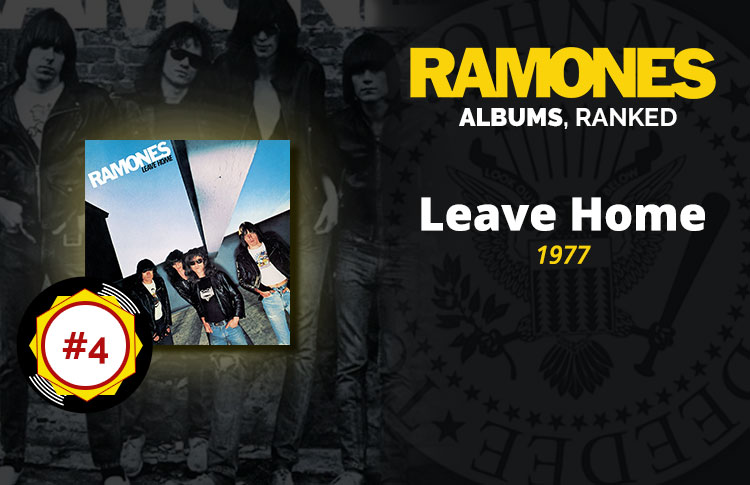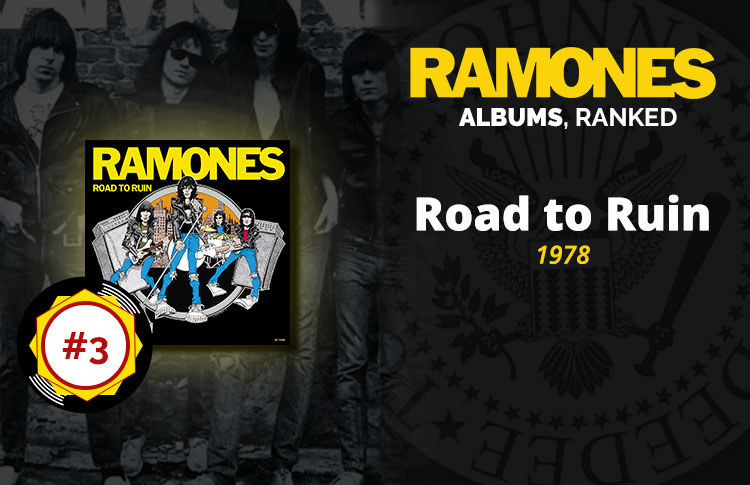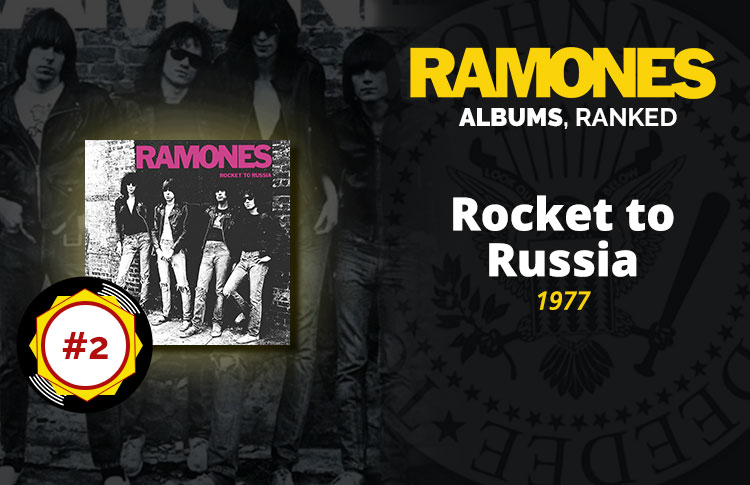
Ranking Ramones’ Studio Albums
The Ramones took the New York City music scene by storm in 1974, making waves nationally not long after. In an era defined by elaborate guitar solos and all things glamor, they stood out as four rambunctious, leather-jacket-clad kids with an aggressive, barebones sound. Were they a return to rock’s rebellious, stripped-back roots or something new entirely? Eventually, the Ramones would be recognized as the vanguard of a new genre of music: punk rock.
You can’t overemphasize the Ramones’ role as the forefathers of punk music. Their signature blend of fast-paced, guitar-driven rock struck a chord with artists as varied as Pearl Jam‘s Eddie Vedder, Green Day, and the Red Hot Chili Peppers. While they never made it big commercially, this influence on other artists established their place in music history.
Perhaps most astonishing about this success is how it was achieved despite many serious obstacles. Between Joey’s mental health issues, Dee Dee’s drug addiction, severe infighting between Joey and Johnny, and many lineup changes, the Ramones had their fair share of problems. Given these odds, it’s incredible that they managed to put out 14 album-length records over 22 years.
Here are those 14 albums, ranked from worst to best.
14. Halfway to Sanity (1987)

Why it’s Ramones’ “Worst” Album
Star cameos and sonic experimentation aren’t enough to save Halfway to Sanity. “Go Lil’ Camaro Go” is a flawed if fun highlight that features Blondie’s Debbie Harry. However, her trademark charm isn’t enough to make this track more than a fun diversion on an otherwise forgettable album. “Garden of Serenity” begins with promise, offering a blend of arpeggiated guitar and heavy drums that wouldn’t sound out of place on a thrash metal record. However, by the end, it devolves into an incoherent mess of Joey yelling “gar-den of se-ren-i-ty” repeatedly. I appreciate the band’s effort to experiment on Halfway to Sanity. Still, it’s one of the few things the Ramones created that just ought to be forgotten.
13. Acid Eaters (1993)

Why it’s Ramones’ 13th Best Album
The Ramones’ only cover album, Acid Eaters, sees the band pay homage to their formative influences from the 1960s. “Have You Ever Seen The Rain” reinvents the Creedence Clearwater Revival track, casting the originally mellow tune as a raucous romp. It’s a riot to listen to, especially when you’re a fan of the original like I am. The rest of the album follows that same formula with decent results. I wouldn’t say that any of the covers are dreadful, but some adaptations certainly work better than others. Overall, Acid Eaters makes for an interesting curiosity, but not much more.
12. Animal Boy (1986)

Why it’s Ramones’ 12th Best Album
Animal Boy’s few standout tracks aren’t enough to save an otherwise lackluster record.
If the band’s previous record Too Tough to Die strikes a balance between newfangled synthesizers, then-modern production techniques, and the band’s usual sound, Animal Boy takes those concepts and turns them up to 11. “Someone Put Something In My Drink” juxtaposes a comically harsh vocal performance with insipid lyrics about having a lousy drink at a bar, while “Something to Believe In” sounds like it was made by an 80s montage song generator, but at least the latter is somewhat fun to listen to. “Bonzo Goes to Bitburg” marks one of the few moments this album is worth listening to. It’s a rousing condemnation of Ronald Reagan’s decision to visit a German war cemetery from World War II and one of the few highlights on this album.
11. Brain Drain (1989)

Why it’s Ramones’ 11th Best Album
By and large, the 80s were not kind to The Ramones. Dreams of making the bigtime fizzled out amidst souring opinions among critics. At the same time, interpersonal conflicts and drug problems reached a fever pitch among the band’s members. You can get a sense of the sheer burnout they felt when you listen to Brain Drain. It lacks the dynamism their albums from the early 80s had, and there’s little to nothing in the way of innovation going on.
“Pet Sematary” is a standout track that briefly brought the band back into the limelight, with its haunting hook and lyrics inspired by Stephen King’s novel of the same name. Another song worth listening to is “I Believe in Miracles,” with its chunky guitar riffs and delightful soloing (yes, a Ramones song with a guitar solo — I know!). Finally, “Palisades Park” is amusing, capturing some of the old Ramones magic. Beyond those three tracks, Brain Drain fails to make waves.
10. Adios Amigos (1995)

Why it’s Ramones’ 10th Best Album
Bar chords, simple if forceful drums, thundering bass lines: it’s all here on Adios Amigos. “I Don’t Want to Grow Up,” originally recorded by Tom Waits, stands out as one of the album’s best tracks. It’s a hilarious declaration of war against adult responsibilities, made that much better by the Ramones’ youthful and fiery sound. Beyond that, nothing else stands out as particularly noteworthy on this record. It’s just a collection of bog-standard punk tracks that aren’t necessarily terrible but not that memorable.
9. Subterranean Jungle (1983)

Why it’s Ramones’ 9th Best Album
Subterranean Jungle marks a true return to form for the band, albeit without the same force and energy that characterizes their early output. Much like those early albums, the songs on this album fall into two categories: abrasive, explosive punk tunes and swooning, old-timey ballads.
“My My Kind of Girl” stands out as a catchy, retro-inspired callback to some of their earlier work, while “Outsider” and “Psycho Therapy” sound like classic Ramones tunes, complete with Johnny’s thundering bar chords and themes of youthful misanthropy. If you’re hankering for a Ramones fix, Subterranean Jungle is not an awful choice.
8. Pleasant Dreams (1981)

Why it’s Ramones’ 8th Best Album
Pleasant Dreams is a record that isn’t quite sure what it wants to be. When it was released in 1981, the world was also unsure what to expect from the Ramones. Would they deliver high-power, nostalgia-fueled yet forward-thinking blend of intense punk music and witty lyrics? Instead, what arrived was a 30-minute testament to the fundamental rift in the band during the early 80s: Joey’s preoccupation with pop and Johnny’s refusal to let go of his beloved punk.
Given the circumstances, however, Pleasant Dreams is hardly a bad album. “The KKK Took My Baby Away” is a gritty if clever depiction of a man begging the FBI for help in finding his abducted girlfriend. Popular legend attributes the song’s inspiration to Joey’s girlfriend leaving him for Johnny, which makes sense given the politically-charged animosity between the two bandmates. (It’s worth noting that multiple other band members dispute this claim.) “7-11” is a surprisingly charming ode to adolescent love that pairs well with the heavier “She’s a Sensation” while “We Want the Airwaves” sums up the band’s obsession with making the big time. The album’s other songs — with the exception of the bizarre, corny “It’s Not My Place (In the 9 to 5 World)” — are fine. Pleasant Dreams isn’t amazing, but it’s hardly atrocious.
7. Mondo Bizarro (1992)

Why it’s Ramones’ 7th Best Album
Mondo Bizarro sees the Ramones fuse pop rock, hard rock, and punk into one of the best albums from their late career. “Poison Heart” jumps off the album as an impeccably produced song just meant for radio. Reaching number six on Billboard’s Modern Rock chart, it gave the band the mainstream attention they had been craving for years. It’s a feisty, poignant hard rock song about feelings of alienation and longing that stands among one of their best singles; I particularly love the arpeggiated guitar work. “It’s Gonna Be Alright” is more in the spirit of their traditional material, both in terms of instrumentation and lyrical content. Mondo Bizarro is a ton of fun to listen to, even if it lacks the variety of some of their other albums. It’s occasionally dated, especially when it comes to the PMRC-inspired “Censorshit,” but it’s great for what it is.
6. End of the Century (1980)

Why it’s Ramones’ 6th Best Album
End of the Century continues The Ramones’ foray into pop territory, exploring new forms of songwriting and instrumentation with commendable results. The album opens with “Do You Remember Rock’ n’ Roll Radio?,” a bizarre melange of circus organs, horns, and drums that wouldn’t sound out of place in the Rocky Horror Picture Show. Yet, beneath this raucous exterior lies a deep anxiety over rock music’s place in a new decade, one seemingly driven more by music videos and synthesizers. If the Bungles’ “Video Killed the Radio Star” accepts the end of rock radio as an inevitability, this track is a rousing call for resistance: ironically, a resistance that seems unnecessary with the gift of hindsight. Either way, it’s a superb track and my favorite from the album.
Some other retro callback tracks include “Baby I Love You,” a straightforward cover of the Ronettes’ classic song, complete with swooning orchestral parts and Joey’s impassioned vocals, as well as “Danny Says.” Listeners not enamored at the thought of a constant nostalgia trip will find relief in tracks like “Rock ‘n’ Roll High School” and “Chinese Rock.” Across the board, End of the Century is a satisfying album. Was it worth the band being held at gunpoint by their producer? Probably not.
5. Too Tough to Die (1984)

Why it’s Ramones’ 5th Best Album
Once you get past the corny album cover, Too Tough to Die makes for a surprisingly great listen. Tracks like “Chasing the Night” and “Howling at the Moon (Sha-La-La)” seamlessly incorporate synthesizers and more traditionally 80s elements into the band’s signature blend of punk and pop. There’s a little bit of cheese, but it’s so endearing that you can’t help but love it.
The track “Too Tough to Die” sounds like it’s a re-recorded demo from the band’s early days, a fact which many traditional fans will appreciate, while “Wart Hog” hilariously imitates hardcore bands such as Dead Kennedys and Minor Threat. Too Tough to Die flies under the radar, but it’s genuinely one of the Ramones’ finest albums.
4. Leave Home (1977)

Why it’s Ramones’ 4th Best Album
If the first four Ramones records were siblings, Leave Home would be the angsty middle child ignored by everyone else. I hate to admit it, but when I was working on this article, I forgot that Leave Home existed for a moment and went straight from Ramones to Rocket to Russia! Shame fills my heart at such a thought because Leave Home is an excellent record in its own right.
Leave Home is the band’s sophomore effort, so it doesn’t deviate much from the formula set out in their debut effort. It’s all about hard-hitting, no-frills instrumentals blended with impassioned vocals discussing topics as varied as teenage love and drug abuse. Who said you had to reinvent the wheel, especially when your particular wheel is terrific at what it does? “Gimme Gimme Shock Treatment” soars under the weight of relentless guitars and conversational vocals, while “Oh, Oh, I Love Her So” worms its way into your head with its incredibly catchy chorus. However, the album’s pride and joy is “California Sun,” a superb cover of a 60s surf rock track. It’s hard not to like a song about meeting your girlfriend at a Burger King and having fun at the beach, right?
3. Road to Ruin (1978)

Why it’s Ramones’ 3rd Best Album
Road to Ruin builds upon the band’s earlier releases, presenting a specific blend of traditional punk songs and slower, poppier love songs. “Don’t Come Close,” “Needles and Pins,” and “Questiongly” showcase Joey’s vocal charisma to the sound of jangly guitars and poppy drums. Ramones purists may disapprove of such tracks, but the provide an endearing and refreshing change of pace. “Needles and Pins” embodies the band’s ability to take old school, 1960s rock tracks and deliver them with a uniquely Ramones sensibility.
Make no mistake: punk aficionados have plenty to love about Road to Ruin. “I’m Against It” is a hilarious manifesto praising contrarianism, railing against the idea of having strong opinions, highlighting the Ramones’ ever-present sense of self-awareness. I would be remiss, of course, not to shout out “I Wanna Be Sedated” as a standout track. It’s a raucous, tightly organized punk ditty that ranks up there with the best of the Ramones singles; it’s famous for a reason!
2. Rocket to Russia (1977)

Why it’s Ramones’ 2nd Best Album
Rocket to Russia‘s origins lay in the hot, hot summer of 1977. Buoyed by two critically successful, if commercially underwhelming records, the Ramones sought to ride the punk craze to the top of the charts. The hopes and dreams of punk fans everywhere rested upon their shoulders, with many hoping that the Ramones could break through to the mainstream in the same vein as the British Invasion bands of the 1960s.
While Rocket to Russia didn’t meet the band’s expectations for sales, it was a smash hit with critics and fans alike. Tracks such as “Rockaway Beach,” an ode to summertime fun at a Queens beach, and a cover of the Bobby Freeman song “Do You Wanna Dance,” illustrate a thematic preoccupation with 1960s pop music. While they wore these influences on their sleeve on their previous two records, it comes out strongly on this album.
However, that isn’t to say that Rocket to Russia eschews other themes. “We’re a Happy Family” dissects a middle-class American family’s neuroticism and dysfunction through a comical lens, while “Teenage Lobotomy,” as the name suggests, tells the story of a teenager subjected to a cranial lobotomy. Only the Ramones could weave themes as disparate as mental illness and surf culture nostalgia into a coherent (and excellent) album.
1. Ramones (1976)

Why it’s Ramones’ Best Album of All-Time
The Ramones first started performing in 1974 — mainly at Manhattan mainstays CBGB and Max’s Kansas City. Over the next two years, they slowly built a name for themselves, networking with other famous musicians and music industry personalities while cultivating a loyal fanbase. This hard work paid off when they signed to Sire Records in 1975. Not long after, they began work on their debut album.
In terms of instrumentation, the guitars on Ramones are heavy yet not overbearing, with little to nothing in the way of traditional soloing. The drums and bass form a solid backdrop for Joey’s signature vocals and really come into their own at times. A distinct 1960s pop influence comes through on the track “I Wanna Be Your Boyfriend,” complete with jangly guitars and charmingly romantic lyrics. Thematically, the band draws on a wide variety of sources, ranging from the banal (“Now I Wanna Sniff Some Glue“), the whimsical (“Beat on the Brat“), and the macabre (“Chain Saw“).
Simply put, Ramones is one of the best debut records of all time. For an album recorded in a week, it’s polished yet intense, and it still sounds fresh nearly 50 years later. Unlike some of their later releases, there are no corny or dated tracks on this album, mainly because the band doesn’t take themselves too seriously. Indeed, this balance between hard-hitting aggression and a whimsical, youthful sense of fun makes Ramones an incredible listen. It’s this eclectic tendency, in terms of instrumentation and lyrics, that makes Ramones what it is: a superb debut record and the best album that the Ramones have to offer.






